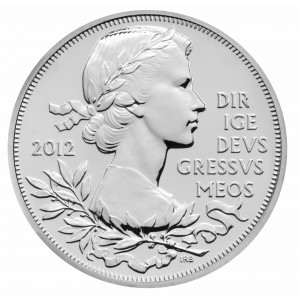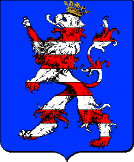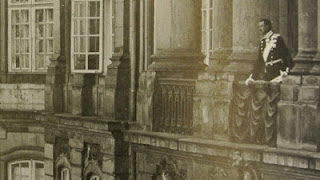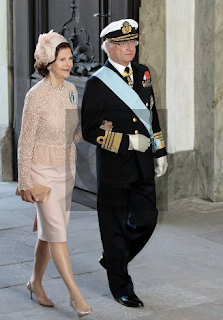Today Archduchess Helen of Austria (née Toerring-Jettenbach) celebrates her 75th birthday!
Countess Helen zu Toerring-Jettenbach was born at Schloß Winhöring on 20 May 1937. She was the second child of Count Carl Theodor zu Toerring-Jettenbach and of his wife, Princess Elisabeth of Greece, herself the middle daughter of Prince Nicholas of Greece (1872-1938) and Grand Duchess Helen Vladimirovna of Russia (1882-1957). Count Carl Theodor Toerring-Jettenbach's parents were Count Hans Veit zu Toerring-Jettenbach (1862-1929) and his wife Duchess Sophie in Bavaria (1875-1957), herself the daughter of Karl Theodor, Duke in Bavaria (a brother of Empress Elisabeth of Austria) and of his second wife Infanta Maria José of Portugal, a daughter of King Miguel I of Portugal.
Interestingly, this Portuguese ancestry connects Helen to a plethora of royal personages. Maria José's siblings included: The Duke of Braganza (whose descendants include the present holder of the title, Dom Duarte, as well as descendants in the houses of Liechtenstein and Thurn und Taxis); Archduchess Maria Teresa of Austria (last wife of Archduke Karl Ludwig [1833-1896], a brother of Emperor Franz Joseph as well as the great-grandfather of Archduke Ferdinand, Helen's late husband); Grand Duchess Maria Anna of Luxembourg (who married Grand Duke Guillaume IV and who was the mother of six daughters, among them Grand Duchesses Marie Adelaide and Charlotte, as well as Crown Princess Antonia of Bavaria); and Duchess Maria Antonia of Parma (who was the second wife of Duke Robert, by whom she had twelve children, among them: Prince Felix of Luxembourg, Empress Zita of Austria and Duke Francesco Xaverio of Parma, to name a few).
Helen passed the war years in Bavaria, where her family felt protected from the atrocities consuming Europe. Her father's opposition to the National Socialists and her mother's outright and intense dislike for Hitler and his cronies made it imperative that then family remain in semi-isolation, while living quietly. The fact that Princess Elisabeth's sisters (Olga of Yugoslavia and Marina of Kent) were married into families that opposed Nazi Germany during the war only made life more fragile for the Toerring-Jettenbachs.
With peace in 1945 also came an opportunity for the family of Countess Helen to renew long-lost connections to their royal relations outside Germany. Visits to Athens to see Grand Duchess Helen and other members of the Greek royal family were soon arranged, while others traveled to Bavaria to reconnect with the Toerring-Jettenbachs. Luckily, Schloß Winhöring was unscathed by the ravages of war and the bombings that Munich underwent.
Tragedy, however was also around the corner. In 1955 Princess Elisabeth succumbed, quite rapidly, to a malady that she had been fighting against. The previous year the family of Grand Duchess Helen, a widow since 1938, suffered a sad blow when Prince Nicholas of Yugoslavia, second son of Princess Olga and Prince Regent Paul, died in a car crash in England.
However, as life always does, great loss is oftentimes replaced by deep happiness. Such was the case in 1956 when Countess Helen married a longtime family friend, Archduke Ferdinand of Austria (1918-2004), eldest son of Archduke Maximilian (1895-1952) and of his wife Princess Franziska zu Hohelonhe-Schillingsfürst (1897-1989). Ferdinand and Helen were to be married for nearly five decades.
The couple were blessed with three very attractive and delightful children: Elisabeth (1957-1983), Sophie (b. 1959) and Maximilian (b. 1961). They were raised in various European countries as Archduke Ferdinand's business obligations demanded relocation every so often. However, throughout the family remained much attached to London, Munich and Salzburg, where Ferdinand's mother lived. They also retained countless links to most of their royal relations across the continent, particularly with King Constantine II of the Hellenes and Queen Sophie of Spain, as well as with Helen's first cousins of Yugoslavia and Kent.
In October 1982 Helen's eldest daughter, Elisabeth, married an Australian gentleman by the name of James Litchfield. The couple settled in faraway Australia and hoped for a long life together. Sadly, it was not to be as Archduchess Elisabeth passed away quite suddenly at Myalla, Cooma, Australia, on 18 May 1983.
In the meantime, Archduchess Sophie, who can easily be argued is one of the most strikingly beautiful royals, was making a name for herself as both a top model and an humanitarian devoted to orphaned children. After several attempts at finding a soul mate, Sophie married Fürst Hugo zu Windish-Grätz in 1990. The couple settled in Italy, where Furst Hugo has vast interests as well as playing an important role within the Vatican's administrative structure. Hugo has also served as Ambassador of the Sovereign Military Order of Malta.
Hugo and Sophie had three children: Hereditary Prince Maximilian (b. 1990), Prince Alexis (1991-2010) and Princess Larissa (b. 1996). The death of their son Alexis, which Eurohistory covered in our Issue LXXXIII (February 2010), was a deeply sad tragedy for the boy's parents and his grandmother Helen. Christian fortitude and a deep belief in Catholic principles allowed the family to find the strength to overcome this immensely challenging loss.
The family's benjamin, Archduke Maximilian settled in Madrid, where he works in the medical device field. Maximilian Heinrich Ferdinand of Austria was born in Boulogne-sur-Seine in 1961. In 2005 he married Maya Al-Askari, a lovely lady whose family proudly claims descent from the Prophet Mohammed. Max and Maya have been blessed with three children: Archduke Nikolau b. 2005), Archduke Constantin (b. 2007) and Archduchess Katharina (b. 2010). All children were born in Madrid, where Max has lived for the better part of the last quarter century.
In 2004 Archduchess Helen lost her husband, who succumbed to a long malady. I first met Archduchess Helen a month after she became a widow. Since then she has been not only an active supporter of my labors dealing with European royalty, but also someone I am honored enough to consider a friend. I have always been very taken by her bonhomie as well as her inner strength to deal with whatever challenges life sends her way. Archduchess Helen's deep belief in Catholicism as a way of life and a source of solace has inspired me to pay more attention to the goodwill found in the faith of my upbringing.
Two years ago, for example, when I was battling cancer and living through a dark period of despondency, Archduchess Helen was kind enough to include me in he prayers. I was deeply touched and thankful!
Today, on Archduchess Helen's 75th birthday, we at Eurohistory, and I personally, wish her the very best and may God continue keeping a watchful eye over the life of a truly lovely lady...
The christening of Archduchess Helen in 1937. Holding her is her grandmother and namesake, Grad Duchess Helen Vladimirovna of Russia.
Princess Elisabeth of Greece (Countess zu Toerring-Jettenbach) with her children Hereditary Count Hans Veit and Countess Helen – Schloß Winhöring, c. 1944.
Princess Olga of Yugoslavia, Archduke Ferdinand of Austria, Countess Helen zu Toerring-Jettenbach and Princess Marina, The Duchess of Kent.
Archduchess Helen on her wedding day.
Archduchess Helen with her eldest daughter, the late Archduchess Elisabeth.
The baptism of Archduke Nikolaus: Prince Alexis, Princess Larissa, Archduchess Helen with baby Nikolaus and Hereditary Prince Maximilian.
Archduchess Helen of Austria and her brother Count Hans Veit zu Toerring-Jettenbach.
Archduke Ferdinand and Archduchess Helen of Austria.
Archduchess Helen of Austria.









































 ©Rex Pictures
©Rex Pictures









